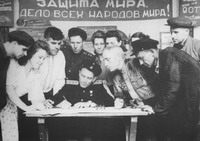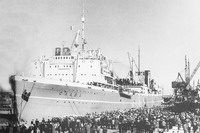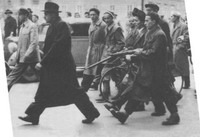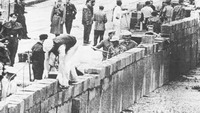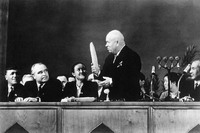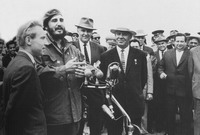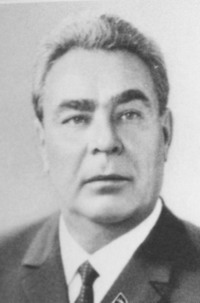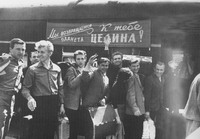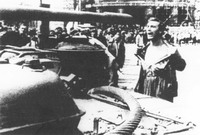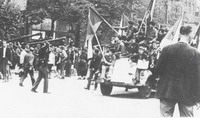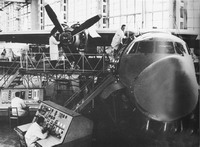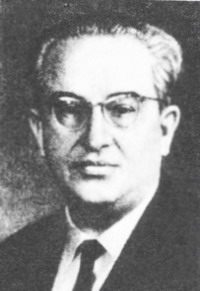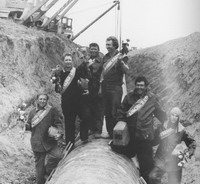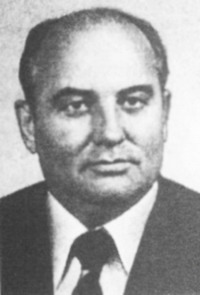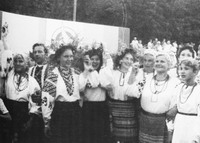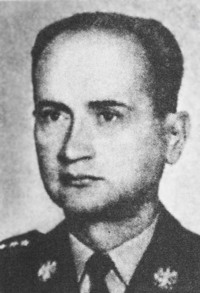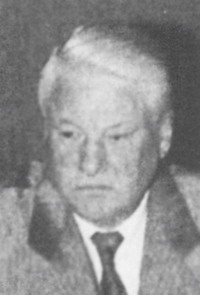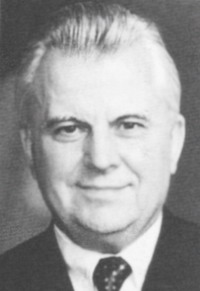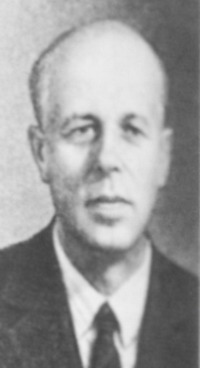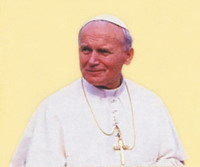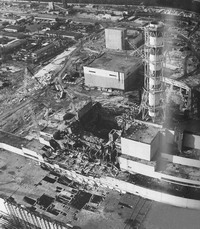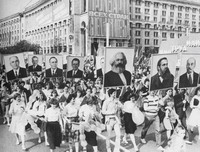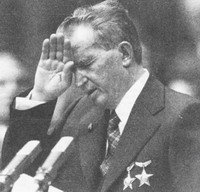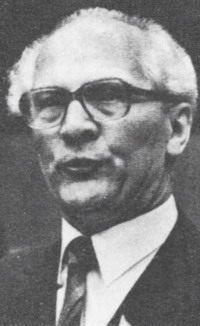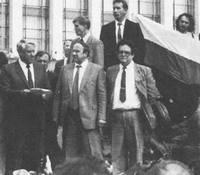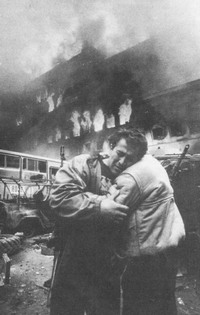§19. USSR of "stagnation" to collapse

1. "Stagnation". USSR during the systemic crisis
The period 1964-1985 he inhistorical and political literature was shaped called "stagnation". Thisimaginative title does not accurately reflect the processes occurring in the second half60's - early 80's, but reflects the general trendsocio-economic and political development of the Soviet system. "Stagnation" is notinvolved the termination of development. Reforms were carried out (second half60 years), implemented in five yatyrichni plans, etc. Active building was renovated.For those times typical achievement of relative social and materialstability, relatively decent compared to previous periods of livinggeneral population. Description of "stagnation" is that the Soviet regimeembraced the systemic crisis which manifested in all spheres of life: economypolitical, social, public morality and so on.

Constructionblast furnace. Dnipropetrovsk, 1967
Scheme: The structural crisis of the Soviet model of socio-political development
Economic Crisis:
- shortage of goods;
- failure or slow introduction of new technologies;
- low quality of most goods;
- food crisis, chronic crisis in agriculture;
- hidden inflation (price increases at constant wage;
- most extensive way of economic development;
- zatratnist high production, consumption of materials and energy production;
- appearance of the shadow economy ("their members").
Political crisis:
- military adventures and the inability to get out of them (Afghanistan, Ethiopia, Angolaetc.);
- senior management's inability to respond to new trends in the world."Aging" of leadership for 1982 average age of senior managementexceed 70 years);
- inability of legislative bodies, all major issues solvedin a narrow circle of top party leadership;
- loss of dynamism in the development of the Soviet model and accordingly itsattractiveness for other countries;
- corruption in higher echelons of power: corruption, criminalization, promotionrecruitment, the principle of love, family ties, personalcommitment;
- increased repression against dissidents (dissidents).
Ideologicalcrisis:
- disappointment in the correctness of the chosen path of development (construction of communism);
- differences between ideological dogmas and realities of life;
- awareness of unreality goal of building communism;
- growing dissident movement and mood in society;
- strengthening ideological pressure on society.
Ecological Crisis:
- thoughtless exploitation of natural resources;
- lack of scientific justification of location of production facilities;
- destruction of the environment suitable for life (pollutionreservoirs. Atmosphere, etc.);
- gradual degradation of the nation (the genetic changes that increase children's diseasesFertility and unhealthy children, reduce fertility, increase in the numberchronic diseases and more.
Moral Crisis:
- the emergence of the phenomenon of double morality (the differences between the declared style of behaviorand the real aspirations and facilities; irresponsibility and desireshift responsibility to others);
- growing prestige of professions, positions that allow you to receive netrudovyyincome;
-
increase indomestic crimes;
-
desire for a goalillegally;
-
growing number of economic(Economic) crime;
-
increase consumerConfidence;
-
rapid spread of drunkennessand alcoholism.
Stages of the period of "stagnation"
|
Stages
|
Years
|
Characteristic
|
|
І
|
1965-1970 biennium
|
Trying to conduct economic reforms that would streamline a small economy after the USSR "Reformative fever" Khrushchev period (Kosygin reform).
|
|
ІІ
|
1970-1982 biennium
|
Increase crisis, "conservation" of the existing system in the USSR
|
|
III
|
From 1982-1985
|
Changes in party leadership. Recognizing the critical situation of Soviet society.
|
2. Official ideologicalconcept. The Constitution of 1977
With the removal of Khrushchev from powerthere is a gradual retreat from the proclaimed policy of directconstruction of communism. In 1967, was put forward the concept of "advancedsocialist society ", which claimed that is not immediately"Leap" in communism. Must pass the time during process which socialism mustdevelop on its own basis. Such socialism called "mature""Developed". In appeared as another term - "real socialism", whichexplained the difficulties that exist in society. Advanced featuressocialist society were noted in the preamble of the Constitution of the USSR in 1977Basic components of developed socialism is "a-national state and the Newhistorical community of people - the Soviet people. " Claimed that whendeveloped socialism society develops without conflicts "scientific"leadership of the Communist Party.
Yuri Andropov concept "developedsocialism "somewhat agreed with the existing realities. He acknowledged the existence ofSoviet society and contradictions of national problems. Solving these problemsshould be done by "restore order" and acceleratedscientific and technical progress.
Construction of developed socialism is notmust stop "fighting the ideological influence of the West." Adopted October 71977 The Constitution (Fourth), except the above-mentioned article in the 6 officialreinforcing leadership and directing role of the CPSU. Constitution utverdzhuvalastrengthen the Union's center for economic and political life bySoviet republics.
Like the previous Constitution, is visibleplace in the Basic Law assigned block social and economic rights, toMoreover, supplemented by new: right to work. To free education and medicalassistance, vacation, pensions and housing. The Constitution alsoreinforcing the empowerment of NGOs.
In general, the Constitution in 1977was of the democratic nature when its provisions do not compare with the reallife.
I wonder
The period of stagnation in the USSR characterizeas neostalinizm - recovery of all economic, political repressionsystem, personality cult, with some regard to the development.
From the very beginning of the eliminationKhrushchev from power brezhnevske leadership is trying to rehabilitate Stalinism andStalin personally. In 1965, The report on the 20 th anniversary of victorythe Great Patriotic War, Brezhnev mentioned Stalin's contribution to the defeatfascism. Hall replied to applause.
At the gathering, XXIII CPSU (1966) wasand the first official attempt of rehabilitation of Stalin. This pre-China reported (Mao Dzedun) and Albanian (Hodge) leaders who activelyinsisted on the abolition of the XX and XXII of `yizdiv. Communist Party of Czechoslovakia, Hungary, Italy,France, Yugoslavia, learned of it and said they withdraw their delegatesin protest. So the attempt was not implemented. However, textbookswas extracted texts of Stalin's personality cult. Began to appear on `books, films,showed that Stalin's special role in history.
The second attempt to rehabilitate Stalintook place in 1969 when Pravda gathered print article that condemned the decision of the twentieth andXXIII of the Communist Party `yizdiv of Stalin's personality cult. At the last minute refused to Brezhnevfrom publication and prepare an appropriate resolution of the CPSU Central Committee.

Leonid Brezhnev(1906 - 1982's)
After the death of Brezhnev, Yuri Andropov, tooprepared a resolution on the rehabilitation of Stalin. But his death interrupted thiswork.
Table.: The Soviet leaders during the "stagnation"
|
Party Leaders
|
Heads of state
|
Heads of Government
|
|
General Secretaries of the CPSU Central Committee (until 1966, the first secretary)
|
Chairman Presidium of the Supreme Soviet of the USSR
|
President of the Ministers of the USSR
|
|
Leonid Brezhnev (1964-1982)
Yuri Andropov (1982-1984)
K. Chernenko (1984-1985)
|
A. Mikoyan (1964-1965)
M. Podgorny (1965-1977)
Leonid Brezhnev (1977-1982)
Yuri Andropov (1982-1984)
K. Chernenko (1984-1985)
|
A. Kosygin (1964-1980)
M. Tihonov (1980-1985)
|
3.A. Kosygin reforms and other reforms of the period of "stagnation".
Top 60's growth rateIndustry and agriculture slowed. Increase in the nationalprofit for the 1958-1964 biennium was reduced by half. Increased gap between demand and itsreal product coverage, especially regarding certain foods.Began raising prices, not only formal but also hidden,is connected with changing product range. One word, in the early 60'sappeared with elements of stagnation phenomena pre-crisis character strengthenedsocial tension in society.
Finding a new management mechanism,which would ensure high production efficiency, has started forKhrushchev. Initiated a broad discussion on economic issues addressedprofessor of the Kharkov Engineering Economic Institute A. Lieberman. In September1962 in Pravda appeared with his article "A plan, and premium income.The article proposed to strengthen the economic independence of enterprises,free from centralized planning fraction blogroll custody of factories andfactories. System put forward by him was based on the principle: it is profitablesociety, should be beneficial to every business.
Discussion of proposalsLieberman contributed to the preparation of economic reform, which became knowncalled Kosygin Reforms "(by the name of the Prime Minister of the USSR).
In 1964-1965 he new schemesshall have been tested and worked out during the experiments that gavepositive results. Then began extending them to all the companies andfarming and management.
Table.: ReformsA. Kosygin
|
Areas covered by the reforms
|
A. Kosygin Reforms
|
|
Industry
|
Improving the planning system and increasing autonomy of enterprises.
Strengthening economic incentives and increase material interest of labor collectives.
|
|
Agriculture
|
Reduction plans compulsory deliveries of grain.
Setting a solid plan to purchase products five years.
Increased purchase prices.
The introduction of premiums for excess production.
The introduction of guaranteed wage workers.
Elimination of restrictions on individual farms farms.
Strengthening logistics collective and state farms.
Subsidies and capital investment in agriculture economy.
|
|
Management
|
The transition from management to the territorial principle industry. Recovery ministries.
|
But unfortunately all measures gave onlyinterim results, especially positive, they affected the implementation of plannedTask five yatyrichky VIII (1966-1970), which is called "gold". In essence, reformwere doomed, because they tried to combine two mutually exclusive economicsystem: the administrative-command and market.
I wonder
Many scientists believe that the Eighthyatyrichka five, five yatyrichka reforms was particularly successful, markedacceleration and rapid increaseproduction efficiency. She even called "gold", the only one that wasperformed. According to official statistics, during 1966-1970 he was values werebest over the 60-80's. For five yatyrichku was built in 1900 (inUkraine 250) new businesses. It created a unified energy system,the process of electrification of villages.
An alternative view.
K. Valtuh, V. Lavrovsky claimthat the results of five yatyrichky somewhat modest.
V. Selyunin and G. Khanin argue thatpresent time economic indicators have deteriorated: in the whole USSRNational income increased by 22% versus 24% for the previous five years,productivity - 17% vs 19%, etc. Worse were usedbasic funds increased production materials consumption, and fastdecreased performance in mechanical engineering. The high figures achieved by reportingexpense of raising wholesale prices. As a result of reform 60 yearslikely to frustrate the old economic mechanism, than create a new one. They onlyidentified the rational economic perspective.
Smallest success achieved in reformagriculture, which still had not provided the necessary countryfood. USSR became one of the world's largest importersagricultural products. New prices, solid plan of putting products, premiums forexcess sales, significant investment for a while stimulatedexpansion of agricultural production. However, experience has shown thatreasons for lagging agricultural sector korinyatsya much deeper and without developmentdifferent ownership and management, without emancipation initiatives andenterprising peasants positive developments in agricultureimpossible.
The industrycommand-administrative system ultimately negated any independenceenterprises. First, the number of targets (performancelabor, average wages, cost of production, etc.). Maintained systemcentralized procurement, which has not changed thesystem wholesale (wholesale) trade. The term 'sales' littledifferent from the "shaft" because sales volumes (in chronic short supplyproducts) grew from increasing output, ie the shaft. Sosaved costly mechanism. Better quality, newsample was economically unjustified. Not operated in practice and Materialstimulation. The more work the firm, the rules were severeformation stimulation funds.
Thus, the reforms were doomed- An internal contradictions and inconsistencies. In addition, the above partyguide to its conduct showed no any interest, although no reformnot abolished. And after the "Prague Spring" (1968) restrained attitude towardsReforms have changed their objections. So the resolution HHIV Congress of the CPSUsaid: "The experience of Czechoslovak events again reminded of the needraise the alert to his deceptions and agents of imperialism in thesocialist community, the importance of a consistent anti-rightopportunism, which under the guise of "improving" socialism tries vyholostytyrevolutionary essence of Marxism-Leninism and clears the way for the penetration of bourgeoisideology.
In 1979, Soviet leadershipcarried out another attempt to revive the economy by improvingeconomic mechanism and enhance the role of party leadership of it. Butsharp acceleration of the economy has not happened. There has not given any positiveresult of the creation of large agro-industrial complex (AIC) and the adoption of "FoodPrograms "(1982).
The latest attempt to implement"Large-scale economic experiment, which involved the weakeningcentralized planning and distribution, some changes in the pricing levelindividual enterprises and regions have been taken in 1983 by GeneralSecretary Yuri Andropov. This experiment was conducted against a background of tough measuresGuidance labor discipline by security agencies. But his shortstay in power can not occur given "experiment", althoughwas observed some economic growth.
The average annual growth over five yatyrichkamy (%)
|
Indicators
|
VIII
(1966-1970)
|
ІХ
(1971-1975 )
|
Х
(1976-1980)
|
ХІ
(1981-1985)
|
|
Gross public product
|
6,7
|
5,6
|
3,4
|
3,5
|
|
National income
|
6,7
|
4,6
|
3,4
|
3,7
|
|
Capital investment
|
6,8
|
6,4
|
2,1
|
3,1
|
|
Labour productivity
|
6,1
|
4,1
|
3,0
|
3,8
|
|
Industrial Products
|
8,4
|
7,2
|
3,9
|
3,5
|
|
Used products
|
3,2
|
3,0
|
1,6
|
0,5
|
I wonder
1.
Incomes of the Soviet Union for 70-80-years of oil exports amounted to 180 billion dollars. Most of them were spenton military-industrial complex, for the purchase of agricultural products and goodsconsumer goods.
2.
During 1960-1987 he was the mainfoundations of the economy (equipment, machinery, buildings) increased 8 times, andtheir returns gone down 2 times.
3.
With 160 million tons of steelvyplavlyalasya in the USSR, 20 million tons went toshavings.
4.
60% of thatproduced no benefits from demand.
5.
At one point weaponproducing countries of NATO, the USSR produced 7.
6.
Shadow Economy("Their members") consumed 10% of the resources produced - 20% of national income.
7.
Top 80'sUSSR produced more than U.S. tractors - 5 times; iron ore - 4 times;oil, cement, steel, machines - 2 times.
8.
In 70 years of industrialproduction in the USSR amounted to 33% of the U.S., agriculture -14%.
9.
The relative reduction inSoviet expenditures on scientific research, deepening scientific and technological gap withUSA. Thus, in 1985 worked in the U.S. 1.5 million new computers and 17 million personalcomputers, then the Soviet Union - only a few tens of thousands of similar machinesoutdated models.
10.
In the early 80's inindustry manual labor was 40%, construction - 60%, agriculture- 75% of.
4. Socialpolitics
Social policy of the Soviet Unionalways been the object of his pride: the absence of unemployment, the lowest in the worldprices for bread, milk, rent, free education and health servicesetc.. However, the period of stagnation in this area there were negative effects. In thisbetween the social sphere funded solely by the residual principle. What isquickly began to give negative manifestations. Thus, in 80 years significantly reducedhousing construction, which immediately increased the housing problem. In 1984,was built as square. of housing, both in 1960 (Please note here thatsquare apartments in new buildings has been doubled to more than 60 years).
Insert of expenditure on public health,directly affected the condition and quality of public services. Yes, if 60'syears in the USSR was the world's lowest mortality rate, in 80 years the USSR haswas for 35 cities on life expectancy and 50 th in the infantmortality.
Top 80's muchexacerbated the food problem. To cover the shortage of agricultural productsspent billions of dollars. The main source for the purchase of oil exports and aother natural resources. Actually was eating natural resources.Food difficulties led to the fact that in 70 years in some regionsbegan to appear on 'ration card. There was a hidden price increase. YesIf big cities are more or less provided with agricultural products at lowstate prices, the population of small towns could only acquire it throughCooperative trading or markets, where prices were considerably higher.
In 70-80's began a rapidreduction in real incomes. The level of consumption in the Soviet Unionthis period took place in the world 77.
All this testified to the fact thatmaintain superpower status was possible only due to the relative increaseexploitation of workers, reduction of social programs, ruthlessexploitation of natural resources.
5.Dissident movement
Hruschovska "thaw" gave birth to hopeand at the same time brought disappointment. The update process developed societyextremely inconsistent. Meanwhile, young people experienced the taste of freedom, soughtdrastic changes. The fact that the reforms of Khrushchev wore superficial and that they do nottouch the foundation of totalitarianism led to a dissident movement thatacquired its distribution after Khrushchev's removal from power.
Sectarianism(Dissenting) - Performance against the existing political system orgenerally accepted norms of a country, the official ideology of confrontation andpolitics defections from the ruling doctrine of the church.
Periodizationdissident movement in the USSR
|
Infancy (1965-1972)
|
Activity A. Sinyavsky, J. Daniel, A. Amalrik, L. Chukovskogo, A. Ginsburg, Halanskoho Yu, B. Bukowski, A. Marchenko, S. Kovalev, L. Boharaz, P. Grigorenko and others.
The beginning of the campaign against Andrei Sakharov and Alexander Solzhenitsyn.
|
|
Crisis Period (1973-1974)
|
The process of the anchor and P. V. Krasin
|
|
Period wide international recognition (1974-1975)
|
Geographical extension dissident movement.
Expulsion A. Solzhenytsyna the country.
Formation of the Soviet branch Amnesty International.
Award A. Sakharov Nobel Prize
|
|
Helsinki period (1976-1982)
|
Activity Helsinki group. Processes over Orlov, A. Scheranskym, G. Yakunin, A. Marchenko.
Extradition of Andrei Sakharov.
|
Dissident movement in the second half60's - early 80's compared to the movement period of Khrushchev"Thaw" had its own peculiarities: it is more massive and organized, wereIllusions of rejected ideas of socialism and communism, the movement became pronouncedantytotalitarnym; dissident views in almost all proslidkovuvavsyaideological spectrum, being established communication with the public and the Westinternational human rights organizations, denied violent methodsstruggle; dissidents seeking to legalize their activities, 80% of dissidentswas the intelligentsia.
|
for socialism with "human face";
|
National Liberation
|
Democratic Human Rights
|
religious
|
In its fight against dissidents usedfollowing methods: events, letters of protest to the governing bodies of the USSR;protests, open letters, appeals to the international organizations, governmentsdemocratic countries, the publication and distribution of samizdat, the action of solidarity withother nations that have suffered oppression from totalitarian system, supportCrimean Tatars in their quest to return to their homeland, defending the ideaequality of peoples, distributing leaflets, individual protests, creatinghuman rights organizations.
Since the mid 60'sbegan continuous years, although nechyselni, performances and against the Communistsystem and against the communist ideology.
In the early 70's dissidentmovement was strong and the regime felt it a threat. In 1972, place overall"Pogrom" human rights movement. Were used broad repression ofits participants. The movement was weakened by the fact that some of its members agreed tocooperation with the regime and began to encourage others to do so. However, the most famousroad users - Academician Andrei Sakharov (author of the Soviet hydrogenbombs) and writer Alexander Solzhenitsyn began baiting campaignthrough the media. In 1974 Solzhenitsyn was by forcedeported abroad, and Sakharov was actually under house arrest.

Andrei Sakharov
Of note the KGB and the Prosecutor General in the Soviet Central Committee (November1972)
Inaccording to the instructions of the Central Committee KGB are significant preventivework to prevent crime, curb subversive actions organizedof nationalist, revisionist and other anti-Sovietelements and the localization of nascent groups in some places politicallyharmful nature.
Bypast five years found 3096 such groups profilaktovano 13 602 people.,that went into their composition?
Similargroup were found in Moscow, Sverdlovsk, Tula, Vladimir, Omsk, Kazan,Tumen. In Ukraine, Latvia, Lithuania, Estonia, Belarus, Moldova, Kazakhstanand other cities.
After the Soviet Union in Helsinkisigned an agreement on human rights, dissident movement strengthened. In1976 Groups emerged to promote implementation of the Helsinki Agreements in the USSR("Helsinki group") in Moscow, in Ukraine, Lithuania, and anotheryear - in Georgia and Armenia. Organizers of the groups knew that the Soviet Unionsigned only for ideological effect, but actually it is going toperform. So they took over public control over performancesigned document. In Ukraine, the known members "Helsinkigroups were Lev Lukyanenko, Vyacheslav Chornovil, Mykhaylo Horyn and others.
Zamyslyvshy intervention in Afghanistanand assuming that the reaction it will cause in the world, the Kremlin regime has decided toat least neutralize domestic opposition. In November 1979arrests were members of the "Helsinki group" - Postershuman rights movement. In 1980, Academician Sakharov was sent tolink to the closed city for foreigners Gorky (now Nizhny Novgorod).
Top 80years, almost all active members of the dissident movement were in custody orin exile.
Despite the repression by the KGBmovement for human rights in the USSR has not stopped, it is replenished with new people.In the first years of restructuring to raise its international prestige, the regime wasforced to give nearly all inmates will of dissidents.
Dissident movement in the USSR is one ofoutstanding historic sites. Quite a small group of intellectuals graduallyspread ideas of democracy, awakened the national consciousness and pushedpublic opposition to the existing system.
2. Reconstruction (1985-1991 biennium).
In mid-80's swept the USSReconomic, social and political crisis. Totalitarian system withcommand-administrative methods has been the time.Faces an urgent need to update all parties of society, its economicbases of social life, political structure, the spiritual sphere.
In March 1985 asSecretary General of the Central Committee elected Mikhail Gorbachev.

Mikhail Gorbachev
From the speech of the MinisterForeign Minister A. Gromyko during a nomination Gorbachevparticipants an extraordinary plenum of the CPSU Central Committee March 11, 1985
"Healways keeping in focus the essence of the question? direct talks about its positioninterlocutor like it or can not? able analytical approachProblems? He not only analyzes the problems well, and makes generalizations andconclusions?
InMikhail Sergeyevich party approach to people, ability to organize peoplefind common ground with them. This is not to receive? Ability to see the main chain andmajor subordinate minor inherent in a strong degree. This ability -great dignity and dignity? in the person of Gorbachev figure we have a widescale, the outstanding figure, which is worthy to hold the post of GeneralSecretary of the CPSU Central Committee.
Initially, the new leadership is not aware ofentire depth of the crisis that engulfed Soviet society. Out of Crisissituation (ill effects of "stagnation" - then appeared with the term forcharacteristics of the Brezhnev era) was considered to acceleratesocio-economic development (author concept economist Aganbegyan) bydoubling of economic potential and re-engineering productionbased on recent achievements of STC, restore order, eliminate such phenomena asalcoholism and others., renewal of party and state apparatus. At the April(1985) Plenum of the CPSU Central Committee was announced at accelerating ratesocio-economic development.
In 1986, XXVII Congress heldCPSU, where Gorbachev failed to hold a new concept of international relations,pushing into the background "class struggle" and put forward the positionon the relationship of the world's phenomena. He started to gain worldwide recognition,which gave him an extra trump in the struggle for power.
Concrete measures tothe reform (which later became known as restructuring) was not easymatter. Reform in accordance with the traditional command-and-practice proved impossible. Bureaucratic methods gave considerable strain inconducting transformation (this is a clear confirmation ofof anti-alcohol and anti netrudovymy income) and adverse eventsthat completely reversed the reform.
Moreover, the concept of accelerationrevealed its incapacity. Oriented to accelerate developmentengineering, it is further reduced the production of consumer goods andthus reinforced the inflationary trend, the deficit. Unlike traditionalcrises inherent to a market economy, the crisis in the Soviet economy combinednot only the slowdown in performance, but also decreaseproduction. To this was added to inflation (hidden) deficits in the wholesale andconsumer markets.
Then Gorbachev at the JanuaryCPSU Central Committee plenum in 1987 raised the issue of developing human resources policyparties in the restructuring, which was to provide personnel reforms.Simultaneously plenum and launched a new policy of publicity. This policyprovided dosed, controlled by the party disclosing the truth about peopletragic Soviet past in order to restore confidence to the peopleCommunist Party. Also supposed to stop the prosecution ofpolitical views and conduct an open policy towards its citizens.
So the first time in Soviet historyCommunist Party has admitted responsibility for the "deformities" indevelopment of Soviet society. The media initiallytimidly, and then on top of his voice were traced critical motifs. Beganprocess of rehabilitation of the repressed 30-50's. But many people find it difficulthad to overcome stereotypes in the perception of history and modernity. One in forcethat destroyed their ideals to others - because it zachipalo their past,when they made a career of fighting "enemies".
Peculiarsymbol of resistance to changes not only in lives but also in consciousness was the publication innewspaper Sovetskaya Russia "article Leningrad chemistry teacher NinaAndreeva ("I CAN NOT relinquish principles") that actuallyvidstoyuvalosya conservative (Stalinist) model of Soviet history. Appearancearticle meant that the party leadership is a force that shares the positionauthor. At the same time this article was the impetus for the consolidation of conservative forces.
At this time attempt to makereforming the Soviet economy on the basis of "self""Self", "camookupnosti. On the basis of reform lay in two parts:
a) expansion of self employmentgroups (the law on state enterprise and association;
b) expansion of privateinitiative (the Law on Cooperatives, on self-employedactivity).
But implementation of these reformsinconsistency was observed and, moreover, they tried to dig the economy out of the handsbureaucracy. Moreover, the Soviet economy maintained the same trends andbefore: extensity, absolute centralization, command-and-management techniques. Remained exaggerated predominance of mining,engineering, military economy. Militarization of the economy, growthunder construction, hidden inflation and growing deficits.
It has become clear that successfuleconomic reform is impossible without political reform.
|
Stairs economic crisis in the USSR
1985-1988 biennium - cost of construction in progress increased by 38 billion rubles.
From 1984-1986 he - anti-alcohol company led to the loss budget of 10 billion rubles.
1985-1987 he - reduction in income from foreign trade by the fall in oil prices - 21 billion rubles.
The 1986-1990 - mistakes in carrying out economic reforms.
1988-1989 biennium - wage growth is 3 times ahead of national growth income.
1989 - Start falling production volumes.
|
Decisions on political reformsystems were adopted at the nineteenth party conference held in June1988 Gorbachev suggested that higher government authorities to make the Congress of Soviets, andParliament to turn into a permanent legislature. Congress of Sovietsbegan the work of 25 May 1989. His work is fundamentallydifferent from previous sessions of the Supreme Soviet.
Despite the conservativenature of the electoral system, including a significant number of members turned outsupporters of radical reform, united in inter-regional parliamentarygroup, which actually became the parliamentary opposition. Declared its existenceand other groups, members of professional associations and political interests.The most conservative positions held of "Union," which stood forpreserve the unity of the USSR at any cost.
With such a variety of politicalviews of the Verkhovna Rada of the USSR actually turned in speaker, whichmanages sessions and must rule out the majority. This causesmisunderstanding between Gorbachev, who was chairman of parliament of the USSR, while GeneralSecretary of the CPSU Central Committee, and conservative forces in the party, who accused him ofsoftness. Democratization of public life gave impetus to the emergence of politicalparties, popular movements and fronts, the revival of national liberation movementsperformed with the ideas of economic, cultural and national revivalIndigenous nations in their republics. Initially, these movements are opposedSoviet power. By its composition, they were mostly intellectuals.
Summer 1989 the politicalarena goes working class. In July of strikes swept the mining districts:Kuzbass, Donbass, Karaganda. The impetus to the mass strike wasdeterioration of the mining towns of food and toiletriesnecessary. Actually since the summer of 1989 occurring in the USSRperiodic crises in the supply of certain goods: sugar crisis, lack of cleaningmeans "China Crisis", "tobacco crisis", etc. The real reason for strikeswas the inability to command and administrative system reforms that wouldprovided the solution of social problems.
The Government of the USSR, headed by Ryzhkov wasforced to take emergency measures. In May 1990 government decided to promulgateprogram of transition to a regulated market economy. Publishing Programcaused a run on demand. The population began to buy up everything. Realisationprogram had to stop, and the government to dismiss.
Shatalin S. and G. Yavlinsky developedalternative program of "500 days". According to this supposedcreate a foundation for a market economy, privatization of public sectorof private ownership and simultaneously stabilize the financial sector.(Similar to Polish "shock therapy"). However, the program after reviewing itsVerkhovna Rada of the USSR was changed so that the essence of the plan appeared to beemasculated.
In October 1990 Gorbachevsuggested a compromise program. But this compromise, in fact, did not givefor real reform and this program, as it has ever failed. Senior alliedleadership proved incapable of economic reform and this gaveadditional arguments forces that favored the dissolution of the USSR.
Against the background of economic crisis andforming a multi begins to sound more and more demand forElimination of Article 6 of the USSR, which reinforcing leadership of the CPSU instate. At the III Congress of Soviets in March 1990 6 tablespoons canceled. andelected the first president of the Soviet Union Mikhail Gorbachev.
Election 1990 wereturning point in the life of Soviet society. These were the first democratic elections.As a result of the election dramatically changed the deputies, especially inSoviet republics (in the Baltics, Georgia, Armenia Communist Party suffered a completeloss), which further intensified the political struggle.
Fundamental changes in the Soviet Union acceleratedCPSU bankruptcy process. In the past, monolithic (20 million) of the CPSU in 1990 wassplit into different currents. In 1990, oformyvsya organization and division inRepublican Communist Party. One part is switched positions on EuropeanSocial Democrats, the other - took aggressively - communist positions(Communist Party of the RSFSR, which was formed in 1990 and opposed theany reforms).
In July 1990 Held XXVIIICongress of the CPSU. This rally took place at a time when party lost its monopoly onpower. Politburo of the lost functions of the supreme power. Thus was done yeta blow to the Communist Party. Center of political power in the state moves up in the Council. Itled to the fact that the Communist Party began to turn into the "stateparty in the state within a state, with its private lines and networkinformants, encrypted connection, significant material privileges, etc. Byyear after the XXVIII Congress of the Communist Party came out of it more than 4 million people., and everynumber of stopped paying membership dues. Since the party came Boris Yeltsin,Head of Moscow and Leningrad Soviets Hans Popov, AA Sobchak. Participants Dem.organized by the Platform for withdrawal from the CPSU and the creation of the Democraticplatform (later became the Republican Party). Summer 1991 partCP RSFRR members, a new party - the Democratic Party of CommunistsRussia, headed by O. Rutskym. At the same time began to form the Movement for Democraticreform, the leaders of which were Yakovlev, Shevardnadze. This development led toaggressive strengthening of conservative forces in the Communist Party, which in 1991 godecisive action.
Perestroika in the USSR (1985-1991 biennium)
|
Period
|
Dates
|
Characteristic
|
|
І
|
April 1985 - January 1987 (From the April 1985 CPSU Central Committee plenum to January 1987 CPSU Central Committee plenum).
|
Attempts to implement the concept of accelerating socio-economic development. Fighting alcoholism and drunkenness.
|
|
ІІ
|
January 1987 - Summer 1988 (From the January plenum of the CC CPSU to the XIXth Conference of the CPSU).
|
Design Concept adjustment. The beginning of economic reform. Getting personnel changes. Beginning publicity.
|
|
III
|
Summer 1988-May 1989 (From the nineteenth partkonferentsiyi to Congress and the People Deputies of the USSR).
|
Beginning reform the political system. Formation of new state power - the Congress of People's Deputies of the USSR. Beginning of political parties.
|
|
ІV
|
Summer 1989-August 1991 (And by the Congress of People's Deputies of the USSR to try coup August 19-21, 1991).
|
1989 - The activities and the Congress of Soviets of the USSR. Increase the economic crisis. First strike miners. Start building the political opposition.
1990 - Top elimination of the Communist Party monopoly on power. Proclamation of sovereignty of the Federal republics. Program "500 Days". Strengthening and union opposition center republics.
1991 - Sharp worsening economic situation. The failure of economic reforms. Increase social tension. The split in the CPSU. Attempts to suppress national liberation movements. Development of a new union contract. HKCHP. The end of perestroika.
|
Implications andthe outcome of the restructuring:
1. Elimination of the totalitarian regime in the Soviet Union, destroying the hegemony of the CPSU inpolitical life.
2. The collapse of the USSR. The emergence in its territory of independent states, particularly Ukraine.
3. The collapse of a planned economic system, creating real conditions for the formationmarket relations.
4. Pluralism of public and political life, creating a multi-system.
5. End of the Cold War, changing the balance of power in the world.
6. Elimination of "world socialist system."
Thus,restructuring has led to diametrically opposite results are expected.
3. The collapse of the USSR: causes and consequences
Democratization of society, politics"Glasnost" revived seemed long ago resolved the national question. Fromimprisonment were returning leaders of national movements, which considered. that time the most modernsuitable for the beginning of the active struggle for self-determination. First ofexistence of the national question after talking events in Alma-Ata (Kazakhstan) inDecember 1987, when the city streets with mass protests appearedKazakh youth. She protested against the appointment of a Russian leaderRepublic. Speech was suppressed by force. The following year declared itself moreone national problem. February 20 Regional Council of Nagorno-Karabakh (an autonomousregion within Azerbaijan populated by Armenians, 98%) turned onto refer it to the Armenian. This decision was supported by massrallies and strikes NKAO population. In response Azeri pogroms committedArmenian population in Azerbaijan, pogroms became a city centerSumgait. Under orders from Gorbachev to the city entered the war. Life demandedimmediate change of national policy at the national level, but the center does nothurry to do it.
In April 1989 TbilisiArmy forces were violently dispersed a demonstration of national-democraticforces, blood was spilled.
Meanwhile, political reformsstarted steadily led to greater activation of the national movement. 18May 1989 Lithuania first of the Soviet Republics adopted the Declaration of Sovereignty. In Junethere were bloody clashes between Uzbeks and Turks-Meskhetians in Uzbekistan.
Scheme: The collapse of the USSR
|
 Deep economic crisis Deep economic crisis
|
Structural crisis of the Soviet system
|
Growth national identity
|
Discredit central government and the CPSU
|
Increased ambitions of political leaders and local elites
|
Tselespryamovana activities to undermine the West and the collapse of the USSR
|
|
Drive to the collapse
Trying HKCHP (DKNS) to the coup
19-21 August 1991
|
March 11, 1990 ParliamentCouncil of Lithuania declared the restoration of full sovereignty of Lithuaniastate. At that time the Congress of People's Deputies of the USSR passed a law to regulateorder out of the republics from the USSR. Actions Lithuania generated a backlashin Moscow. Gorbachev appealed to the Supreme Council of Lithuania for the immediate abolitionadopted document. But Lithuania's reaction was negative. Change the position of Lithuaniacould not not political pressure, not an economic blockade. By so doing, put LithuaniaTop Revolution "sovereignty." Most federal and evenautonomous republic adopted the Declaration of Sovereignty. About Statesovereignty of Parliament said RSFRR, headed by Boris Yeltsin stood. Such actionscan be explained by the union struggle and the new Russian political elite, soberassessment of historical realities. Along with the "parade of sovereignty"exacerbated ethnic conflicts (Tbilisi, Karabakh, Baku, etc.).. Theirinitiators were mostly forces that favored the preservation of the Union.
Feeling his weaknessposition, conservative forces begin a massive psychological attack, inciteposition, threatening the inevitability of civil war and large casualties.In February, 1990 USSR Supreme Council granted emergency powersM. Gorbachev. There have been changes in the inner circle Gorbachev.
The coming to power of the reactionaries at oncemade itself felt. January 13, 1991 in Lithuanian capital Vilnius wasan attempt of coup d'
Similar events unfolded in Latvia.By March 1991 situation in the USSR more drawn. Minersbegan an indefinite strike demanding the resignation of Gorbachev, the Soviet Union Parliament, dissolutionCongress of People's Deputies of the USSR, temporary transfer of power in the hands of the Federation Council.
Holding a referendum March 171990 about the future of the Union, where 3 / 4 of the people voted forUnion (the question was worded so that voters had to choose orold Union, or updated), did not stop its collapse. The consequences of the referendum wereoften double. To questions about the preservation of the Union Republican BP added question of whethercitizens approve of the Declaration on State Sovereignty. And most, tooby. In the referendum did not officially participated Baltic republics,Georgia, Armenia, Moldova.
Then Gorbachev took to the newtactical options. In late April 1991 in Moscow residenceNovo-Ogaryovo he managed to sign an agreement with leaders of nine republics offastest train new union contract. Published a Federalagreement changed several times and wore a compromise. The main thing inNovo Ohorovskiy agreement was that after 6 months were to be heldelections in the new Union bodies.
This agreement marked the beginning of negotiationsaccording to the "9 1" and lasted from May to July 1991 Mainissue, which debated, it was about what should be a union -federation or confederation. At the talks the most uncompromisingly positionoccupied by Russia and Ukraine. However, the entrenched power structure in the RussianFederation. June 12, 1991 Boris Yeltsin's general direct elections waselected president.

Boris Yeltsin(1931 - 2007's)
At that time, the reactionary forces thatpartaparat relied on, the tip of the KGB, many of the generals andleaders of the military-industrial complex, intensified preparationsinsurgency.
In the morning of August 19 on the radio andTV was declared disease Gorbachev that alteration,started it reached a deadlock and that all power on takingState Committee on state of emergency (HKCHP). It consists ofG. Yanayev, V. Pavlov, B. Puho, V. Hooks, D. muscular, G. Baklanov - DeputyGorbachev on the Council of Defense, V. Starodubtsev - Chairman Selianskiy Union andA. Tizyakov - one of the leaders of the military industry. In Moscow wereentered the war. The Manifesto was said HKCHP of unrest in the country ofdestruction of the Soviet people. Promised to be supported by private property andthat each family will receive 0.15 hectares of land will be reduced prices and raised wagesfee and that every family receives housing.
But against the insurgency rosedemocratic society. Centers of resistance against the coup was the ParliamentRussia. Already in the morning August 19 Boris Yeltsin issued a series of decrees, which qualified theinsurgency as a coup, Gorbachev demanded connection (connection with whichwas completely turned off), appealed to the workers - to start a generalstrike and the military not to obey orders HKCHP. August 21 coup organizershave been arrested. Activity was banned Communist Party, announced the reform of the KGBdecided on a radical military reform. But the main thing was that allUnion republics declared their independence, began to create their own army,take control of allied property.
The Soviet Union began to collapse.September 9, 1991 recognized the independence of Latvia, Lithuania and Estonia.Gorbachev makes an effort to save something from the Union. But the resultsReferendum in Ukraine, December 1, 1991 undermined all attempts to restoreUnion.
Then December 8, 1991 inBia

Leonid Kravchuk -First President of Ukraine
December 21, 1991 wasmeeting in Alma-Ata, where he joined the CIS, Kazakhstan, Kyrgyzstan, Turkmenistan, Uzbekistan,Tajikistan and Armenia. Subsequently, Moldova joined the CIS and Azerbaijan, and in1994 - Georgia. In Alma-Ata Declaration was proclaimeddissolution of the USSR. December 25 Gorbachev signed a decree on the preparation ofthemselves functions of the Supreme Commander and announced his resignation from thepost of President of the USSR. On this day over the Grand Kremlin flahshtotsiPalace was lowered a red flag and raised the flag of Soviet Russia. December 261991 one of the two chambers of Parliament of the former USSR, which couldcollect, adopted a formal declaration of dissolution of the USSR.
The international community has recognizedindependence of all former Soviet republics.
Results
Reformslate 60's not removed the negative manifestations of the Soviet system,potribuvala a radical reform. But the Soviet leadership on the contrary"Conserved" the current system, leading to its overall crisis.Long time, manifestations of the crisis hidden. Only after the leadership changecountry coming to power of Gorbachev were done trying to solve the crisis.But to find an effective recipe failed. The crisis ended with the collapse of the USSR.
Questions and tasks:
1. What period in history and why the USSR was called "stagnation"?
2. What is the essence of the crisis of the Soviet system?
3. What changes have occurred in the official ideological concept in the 70 to 80 years?
4. Why administrative-command system proved ineffective and led to thedegradation of the economy of the USSR?
5. Identify reasons for early remodeling. Give the definition.
6. What periods of adjustment (indicate chronological limits) correspond slogans:"Speeding", "More socialism!", "More democracy!"?
7. Why Gorbachev at the end of tenure enjoyed greaterpopular abroad than in the USSR?
8. In 1862, the Russian thinker N. Chernyshevsky de `yasnyuvav:" Publicity - isbureaucratic phrase coined to replace the phrase "freedom of speech", and inventedfor the idea that the expression "freedom of speech" may seem unpleasant or sharpanyone. Express your opinion on the statements. Is it characterizesprocesses which occurred in the USSR in the late 80 th century.?
9. Discover the reasons of the collapse of the USSR. What was the main reason?
10. What is the role of events August 19-21, 1991, collapse of the USSR?
 English
English



















